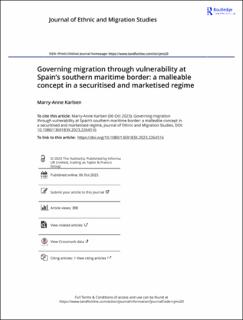| dc.contributor.author | Karlsen, Marry-Anne | |
| dc.date.accessioned | 2024-03-26T13:10:18Z | |
| dc.date.available | 2024-03-26T13:10:18Z | |
| dc.date.created | 2023-10-29T16:12:48Z | |
| dc.date.issued | 2023 | |
| dc.identifier.issn | 1369-183X | |
| dc.identifier.uri | https://hdl.handle.net/11250/3124252 | |
| dc.description.abstract | Vulnerability has emerged as a central policy concept in migration governance. Despite its growing importance, the concept remains contested and ambiguous. As multiple conceptions of vulnerability circulate, it becomes crucial to gain a better understanding of how ‘vulnerability’ might shape practices on the ground. In this article, I explore how different actors in the province of Cádiz, located at Spain and the EU’s southern maritime border, understood, and operationalised ‘vulnerability’. The aim is to advance understandings of vulnerability as a mechanism of governance in the reception of people on the move in the context of so-called ‘mixed movements’. My focus is on how vulnerability as a new classifying label overlaps with and fragments previous labels that underpin migration governance. Through the analysis, I show how the malleability of the notion of vulnerability constituted an opportunity for actors on the ground to challenge categorical and legal distinctions between migrants. However, civil society organisations’ engagement with vulnerability not only represented a ‘push-back’ of restrictive policies but was also a way to adapt and survive in a securitised and marketised regime. | en_US |
| dc.language.iso | eng | en_US |
| dc.publisher | Taylor & Francis | en_US |
| dc.rights | Navngivelse 4.0 Internasjonal | * |
| dc.rights.uri | http://creativecommons.org/licenses/by/4.0/deed.no | * |
| dc.title | Governing migration through vulnerability at Spain’s southern maritime border: a malleable concept in a securitised and marketised regime | en_US |
| dc.type | Journal article | en_US |
| dc.type | Peer reviewed | en_US |
| dc.description.version | publishedVersion | en_US |
| dc.rights.holder | Copyright 2023 The Author(s) | en_US |
| cristin.ispublished | true | |
| cristin.fulltext | original | |
| cristin.qualitycode | 1 | |
| dc.identifier.doi | 10.1080/1369183X.2023.2264516 | |
| dc.identifier.cristin | 2189648 | |
| dc.source.journal | Journal of Ethnic and Migration Studies | en_US |
| dc.source.pagenumber | 873-890 | en_US |
| dc.identifier.citation | Journal of Ethnic and Migration Studies. 2023, 50 (4), 873-890. | en_US |
| dc.source.volume | 50 | en_US |
| dc.source.issue | 4 | en_US |

